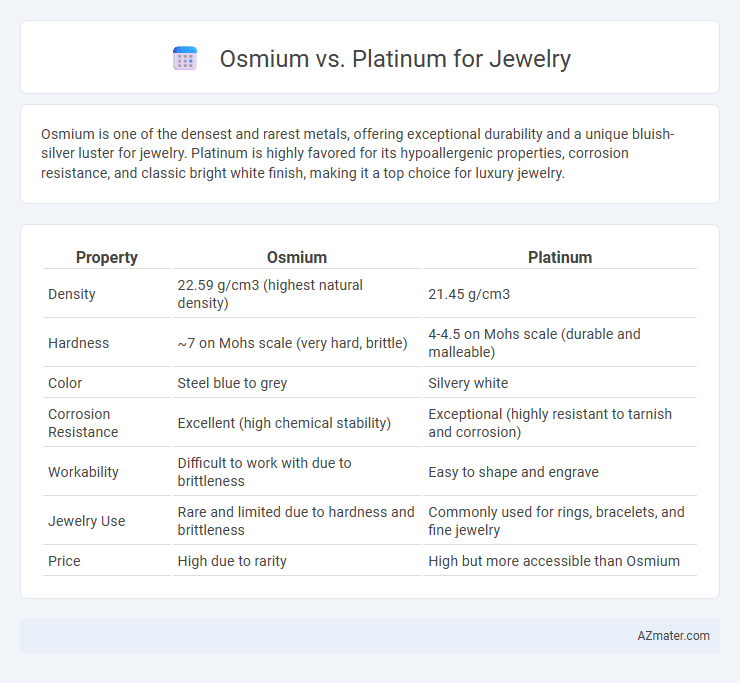Osmium is one of the densest and rarest metals, offering exceptional durability and a unique bluish-silver luster for jewelry. Platinum is highly favored for its hypoallergenic properties, corrosion resistance, and classic bright white finish, making it a top choice for luxury jewelry.
Table of Comparison
| Property | Osmium | Platinum |
|---|---|---|
| Density | 22.59 g/cm3 (highest natural density) | 21.45 g/cm3 |
| Hardness | ~7 on Mohs scale (very hard, brittle) | 4-4.5 on Mohs scale (durable and malleable) |
| Color | Steel blue to grey | Silvery white |
| Corrosion Resistance | Excellent (high chemical stability) | Exceptional (highly resistant to tarnish and corrosion) |
| Workability | Difficult to work with due to brittleness | Easy to shape and engrave |
| Jewelry Use | Rare and limited due to hardness and brittleness | Commonly used for rings, bracelets, and fine jewelry |
| Price | High due to rarity | High but more accessible than Osmium |
Introduction to Osmium and Platinum in Jewelry
Osmium and platinum are rare, dense metals prized in high-end jewelry for their unique properties and aesthetic appeal. Osmium boasts exceptional hardness and a striking bluish-silver color, while platinum offers renowned durability, hypoallergenic qualities, and a naturally white sheen that resists tarnish. Both metals provide luxurious alternatives to traditional gold and silver, appealing to consumers seeking exclusivity and lasting value in fine jewelry.
Unique Properties of Osmium vs Platinum
Osmium offers unparalleled density and hardness compared to platinum, making it one of the rarest and most durable metals for jewelry. Its deep bluish-gray hue distinguishes osmium from the classic white shine of platinum, providing a unique aesthetic appeal. Osmium's exceptional resistance to corrosion and wear enhances its suitability for intricate, long-lasting jewelry designs.
Rarity and Availability of Each Metal
Osmium is one of the rarest and densest precious metals, making it exceptionally scarce and difficult to source for jewelry use. Platinum, while still rare, is more abundant and widely available through established mining operations, contributing to its more consistent supply in the jewelry market. The limited availability of osmium significantly drives its exclusivity and higher cost compared to platinum.
Durability and Hardness Comparison
Osmium is significantly harder than platinum, with a Mohs hardness of around 7 compared to platinum's 4-4.5, making it more resistant to scratches and daily wear. Platinum's superior malleability allows for easier crafting into intricate designs, but osmium's exceptional density and hardness offer unmatched durability in jewelry. The higher durability of osmium makes it ideal for pieces subjected to rough conditions, while platinum remains favored for classic luxury due to its workability and timeless appeal.
Appearance and Aesthetic Appeal
Osmium jewelry features a unique bluish-silver hue with a brilliant metallic luster that distinguishes it from traditional precious metals like platinum, which is renowned for its classic white-silver sheen and high reflectivity. The rarity and distinct color of osmium create an eye-catching aesthetic that appeals to those seeking unconventional and modern designs, while platinum's timeless elegance and durability make it a preferred choice for sophisticated and enduring pieces. Osmium's natural density and hardness contribute to its striking presence, whereas platinum's smooth surface enhances its versatility in intricate jewelry craftsmanship.
Hypoallergenic Qualities and Skin Safety
Osmium and platinum are both prized in jewelry for their hypoallergenic qualities, with platinum being widely recognized for its skin safety due to its resistance to tarnish and corrosion. Osmium, though rarer and heavier, is also hypoallergenic but less commonly used in jewelry, requiring careful handling because of its brittleness and potential for dust particles during cutting. Platinum's established track record and biocompatibility make it a safer choice for sensitive skin compared to osmium, which demands specialized craftsmanship to ensure wearer safety.
Workability and Craftsmanship Challenges
Osmium is significantly harder and more brittle than platinum, making it extremely difficult to work with for jewelry crafting, often requiring specialized tools and techniques to prevent cracking or damage. Platinum offers superior workability due to its ductility and malleability, allowing artisans to shape, engrave, and set stones with greater ease and precision. The craftsmanship challenges with osmium limit its use primarily to small, intricate components, whereas platinum remains the preferred choice for complex, durable jewelry pieces.
Cost and Investment Value Analysis
Osmium's rarity and density make it significantly more expensive per gram than platinum, though its limited market availability restricts liquidity for jewelry investment. Platinum remains a popular choice in fine jewelry due to its well-established market, higher demand, and better resale value, providing more stable investment potential. Cost analysis favors platinum for consumers seeking a balance of durability and affordability, while osmium appeals primarily to niche collectors valuing exclusivity.
Maintenance and Care Requirements
Osmium jewelry demands specialized maintenance due to its brittleness and rarity, requiring careful handling to avoid chipping or cracking, while regular cleaning preserves its unique bluish-silvery luster. Platinum offers higher durability and resistance to scratches and tarnishing, allowing for more straightforward care with occasional polishing to maintain its bright white sheen. Both metals benefit from professional inspections to ensure prongs and settings remain secure, but platinum's robust nature makes it more practical for everyday wear.
Environmental and Ethical Considerations
Osmium jewelry offers significant environmental benefits due to its extreme durability, requiring less frequent replacement and reducing resource consumption compared to platinum. Platinum mining often involves extensive land disruption and energy-intensive processes, raising ethical concerns related to habitat destruction and carbon emissions. Ethical sourcing of osmium, typically a byproduct of nickel and platinum mining, can further minimize negative environmental impacts by utilizing materials that would otherwise be wasted.

Infographic: Osmium vs Platinum for Jewelry
 azmater.com
azmater.com